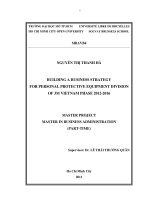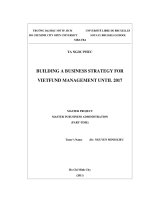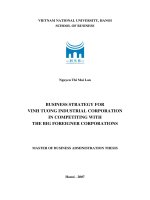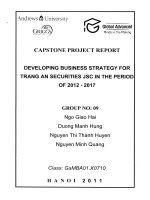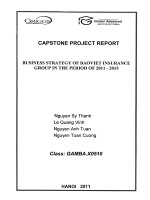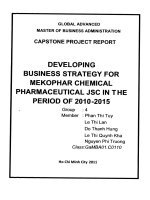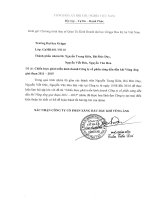Developing a business strategy for Hien Duc joint-stock company in the 2013-2018 period
Bạn đang xem bản rút gọn của tài liệu. Xem và tải ngay bản đầy đủ của tài liệu tại đây (1.2 MB, 103 trang )
COURSE: STRATEGIC MANAGEMENT
Title: Developing a business strategy for Hien Duc Joint-stock company
in the 2013-2018 period
By: Group 02 - M0111
Members:
1- Phan Xuan Tung (Group leader)
2- Nguyen Manh Tuan
3- Pham Thi Thu Huong
4- Pham Thi Hong Thuy
5- Nguyen Kim Toan
Ha noi, 12/2012
CONTENTS
Page
INTRODUCTION
PART I: THEORETICAL BASIS FOR BUSINESS STRATEGY
FORMULATION
1.1.
Overview of strategy and strategic management in business
1.1.1.
What is a business strategy and what is strategic management?
1.1.2.
Process of business strategy formulation
1.1.2.1.
Identification of business strategies
1.1.2.2.
External Factor Evaluation
1.1.2.3.
Assessment of the current situation of the company
1.1.2.4.
Analysis and selection of strategies for the company
1.2.
Tools for formulating business strateties for a company
1.2.1
Stage 1: Collecting Information
1.2.1.1.
External Factor Evaluation Matrix (EFE)
1.2.1.2.
Competitive Profile Matrix (CPM)
1.2.1.3.
Internal Factor Evaluation Matrix (IFE)
1.2.2
Stage 2: Linking between factors for formulation of business
strategies
1.2.2.1.
Strength, Weaknesses, Opportunities and Threats Matrix
(SWOT)
1.2.2.2.
Strategic Position and Action Evaluation Matrix
(SPACE)
1.2.2.3.
Quantitative Stratetic Planning Matrix (QSPM)
1.2.3
Stage 3: Selecting business strategies, implementing, evaluating and
adjusting business strategies.
CONTENTS
Page
PART II: ANALYSIS OF THE OBJECTIVES OF BUSINESS STRATEGY
FORMULATION FOR HIEN DUC JOINT-STOCK COMPANY
2.1.
Overview of Hien Duc Joint-stock Company
2.1.1.
Background information about the company’s establishment and
development
2.1.2.
Organisational structure of Hien Duc Joint-stock Company
2.1.3.
Areas of business activities
2.1.4.
Vision and mission
2.1.5.
Business performance in the 2007-2011 period
2.2.
Analysis of the business environment of Hien Duc Joint-stock Company
2.2.1.
Analysis of factors in the external environment
2.2.1.1.
Analysis of the macro-economic environment usinng
PEST model
2.2.1.2.
Analysis of competitive environment using M.Porter’s
Five Forces model
2.2.1.3.
Analysis of competitiveness using CPM matrix
2.2.1.4.
External Factor Evaluation using EFE matrix
2.2.2.
Evaluation of internal factors of Hien Duc Joint-stock Company
2.2.2.1.
Human resource
2.2.2.2.
Market access capacity
2.2.2.3.
Organisational structure
2.2.2.4.
Financial capacity
2.2.2.5.
Research and development capacity
2.2.2.6.
Evaluation of internal strengths and weaknesses
2.2.2.7.
Analysis using the Internal Factor Evaluation (IFE)
Matrix
2.3.
Rationale for developing a business strategy for Hien Duc Joint-stock
Company in the 2013-2018 period
CONTENTS
Page
PART III: DEVELOPING A BUSINESS STRATEGY FOR HIEN DUC
JOINT-STOCK COMPANY IN THE 2013-2018 PERIOD AND SOLUTIONS
FOR IMPLEMENTATION
3.1.
Business objectives of Hien Duc Joint-stock Company up to 2020
3.1.1.
Overall objectives
3.1.2.
Specific objectives
3.2.
Matrix-based analysis and selection of business strategies
3.2.1.
Analysis using SWOT matrix
3.2.2.
Analysis using SPACE matrix
3.2.3.
Analysis using the QSPM matrix
3.2.4.
Selection of a business strategy for Hien Duc Joint-stock Company
3.3.
Solutions for implementation
3.3.1.
Solutions for human resource development
3.3.2.
Solutions for communication and marketing
3.3.3.
Technological solutions
3.3.4.
Solutions for restructuring
3.3.5.
Solutions for developing company culture
3.3.6.
Financial solutions
3.4.
Implementation timelines
CONCLUSIONS AND RECOMMENDATIONS
REFERENCES
APPENDIX
ACKNOWLEDGEMENTS
First of all, we would like to express our deepest gratitude to all teachers of MBA
program – ETC Center - Hanoi National University, who have provided us with
knowledge and skills to be able to complete this paper.
Last but not least, we would like to convey our special thanks to all leaders and
staffs of Hien Duc Joint Stock Company, who have given us not little support in the
process of data collection, survey and analysis of the different situations. We do hope
what has been presented in this paper could help, to some extent, business management
of the Company in the future.
THE COMMITMENT
This paper is an effort of all members of the group 02, class M0111. We, hereby
would like to certify that the paper is not copied or shared with others except the group
members ourselves to aim at completing the final report. All information provided in this
paper, including data, drawings, graphs, and enclosing documents are all quoted from
official and legal sources. All the data of Hien Duc Joint Stock Company are all
permitted by the Executive Board of the Company with attached certification.
We are committed to take full responsibility toward Hanoi National University,
ETC Center and Andrew University of United States for the accuracy, legality and
transparency of the contents presented in this paper.
Signature of Group Members:
1. Pham Xuan Tung:
2. Nguyen Manh Tuan:
3. Pham Thi Thu Huong:
4. Pham Thi Hong Thuy:
5. Nguyen Kim Toan:
LIST OF ABBREVIATIONS
AS Attractiveness Score
CPM Competitive profile matrix
EFE External Factor Evaluation Matrix
IFE Internal Factor Evaluation Matrix
IE Internal-External Matrix
GDP Gross Domestic Product
SWOT Strengths, Weakness, Opportunities, Threats
PEST Political, Economics, Socio-cultrural, Technological
QSPM Quantitative Strategic Planing Matrix
TAS Total Attractiveness Score
Capstone Project: Strategic Management Page: 1/67
FOREWORD
Hien Duc JSC is a real estate company operating mainly in the Hanoi and Thanh
Hoa market, with capital of roughly over 20 million USD (as of 30/09/2012).
Hien Duc JSC is currently the contractor of several projects, including: HD
BUILDING, Dien Bien market in Thanh Hoa province; HD PLAZA – Thanh Hoa; Hai
Hoa beach resort – Thanh Hoa. And in particular, the high-end, serviced apartment,
office for lease complex in lot D7 – of Phu Thuong ward, Tay Ho Dist. in Hanoi.
Hien Duc JSC has been operating in the real estate business for 8 years. The
company is currently managing its former construction projects, including: Office for
lease HD BUILDING at No. 57 Tran Quoc Toan, Hoan Kiem, Hanoi. This is a 9-story
building, with over 1000m
2
floor area for office lease, meeting C standard for office
buildings. Hien Duc JSC is also managing Dien Bien market in Thanh Hoa city, with
450 kiosks for lease. The company is also speeding up construction and will soon put
into operation the 5-story, 13.000 m
2
floor area HD PLAZA mall in Thanh Hoa. With
its current managing portfolio, the company’s average revenue for the 2013-2015
period is expected to be at 1 million USD.
In the near future, Hien Duc JSC has plans to develop the high-end, serviced
apartment, office for lease complex in the best location in Tay Ho Dist., and also in
Hanoi. It is also undertaking compensation, site clearance work for Phase I (10
hectares) of the Hai Hoa beach resort project in Hai Hoa commune, Tinh Gia Dist.,
Thanh Hoa province. The project will offer products such as: 3-4 star hotels,
international conference centers, amusement parks and other high-end services.
With this portfolio, Hien Duc JSC’s target market and customer are clearly
identified.
As an office building developer, Hien Duc JSC targets SMEs wishing to find
office space in Hanoi’s Hoan Kiem district. In Thanh Hoa, since the Company is
currently working on the Dien Bien market and HD PLAZA mall, its target customers
are clear, mainly small, individual traders (suitable to market model) and prestigious,
well-known domestic brands wishing to expand to Thanh Hoa market.
Moreover, for the two future projects: the high-end, serviced apartment, office
for lease complex in lot D7 – in Phu Thuong ward, Tay Ho Dist. in Hanoi and Hai Hoa
beach resort the company is targeting well-to-do Vietnamese and foreigners (for the D7
project); foreign specialist on extended-stays at the Nghi Son refinery, tourists in
Thanh Hoa and nearby provinces.
Capstone Project: Strategic Management Page: 2/67
Hien Duc JSC establishment and development was during the latter days of the
real estate bubble in Viet Nam. Entering the market in 2004, only in 2010 did the
company’s projects generate revenue like the HD BUILDING at No. 57 Tran Quoc
Toan, Hoan Kiem, Hanoi; the Dien Bien market and mall project in Thanh Hoa. The
Company had high hopes for 2 major projects. The D7 in Phu Thuong, Tay Ho, Hanoi,
and the Hai Hoa beach resort in Hai Hoa commune, Tinh Gia Dist., Thanh Hoa
province with total investment of nearly 200 million USD. However, as of today
(2012), the D7 project have only begun construction of the mall and model replicas,
while Hai Hoa beach resort is still in the site clearance, compensation phase.
2010 – 2012 saw the bursting of the real estate bubble. The global economic
crisis, combined with the weak capabilities of the government in managing the
economy has left huge consequences for the Vietnamese economy, much more severe
than countries in the region. Economic recession, inflation, the collapse of securities,
real estate markets characterizes this period. The slowdown in growth, high inflation
and scores of defaulting businesses has quickly reduced the incomes of a large part of
the population. There have been no optimistic signs of market recovery nor have there
been serious governmental efforts to remedy the severe consequences left in the
economy.
In addition, after 8 years, Hien Duc JSC have not been able to develop a
professional business administration team. Hien Duc’s operation is typical of an
individually-owned, private business. Human resource quality is not very high. The
company does not have a market research division, customer relations have not been
given attention and even the most fundamental sketches of the internal control,
communication and business processes have not been outlined. Investment and
construction are wholly outsourced, from concept to deployment, construction and
installation. Hien Duc’s current operation is simply operation of a simple business unit:
management, account balancing and collection of profit (if any).
Based on the collected information and analysis of the factors affecting the
company’s businesses, the current situation and development level of the Vietnamese
economy and the inherent characteristics of the Company, our Group propose that the
business strategy for Hien Duc JSC for 2013 - 2018 be caution and preservation. 2013-
2018 will be the weathering the storm period for real estate businesses (including Hien
Duc). Since the company will need to strengthen its internal capacities (instead of
relying on its own fund), and the situation may go from worse to worst, a strategy of
caution and preservation will help the company to endure and develop in the future.
Capstone Project: Strategic Management Page: 3/67
PART I: THEORICAL BASIS OF BUSINESS PLANNING
1.1. Overview about strategy and strategic management in business
1.1.1. What is a business strategy and strategic management?
A strategy is a plan of action designed to achieve a specific goal
1
. As such, a
business strategy is a plan of action designed to achieve a specific business goal of a
firm during its operation process. By nature, the basic business goal of a firm is profit.
Along with the increasingly fierce competition in the market economy, the profit goal
of enterprises is converted into various goals such as: existence, development of the
firm, product development, market development, and obtaining position and status of
the firm, etc in the operation process with the ultimate goal of making profit (both in
the short and in the long term) to ensure the firm’s existence and development.
A business strategy is an overall plan of actions designed and implemented to
achieve business goals of a firm in a certain period of time. There are different
definitions of business strategy depending on the research approaches adopted by
different authors. Obviously, the development level of the economy under study is
considered one of the main basis for formation of the definitions of business strategies
given by different authors.
According to Chandler (1962), “strategy is the determination of the basic,
long-term goals and objectives of an enterprise, and the adoption of courses of action
and allocation of resources necessary for these goals”.
According to Quinn (1980), “a strategy is a pattern or plan that integrates major
goals, policies and action sequences into a cohesive whole.”
Fred R.David defines strategy as an “art and science of formulating,
implementing, and evaluating cross-functional decisions that enable an organization to
achieve its objectives”.
According to Garry D.Smith, Danny R.Arold and Bobby R.Bizzell, “Strategic
planning is a process of studying current and future environment, and defining an
organization’s goals; making, implementing and supervising the implementation of
decisions so as to achieve such goals in the current and future contexts”.
Business strategy management is the combination of management of operations,
marketing, finance, accounting, production, research and development and exploitation
1
Capstone Project: Strategic Management Page: 4/67
and use of various of information systems in business aspects to help the firm achieve
such goals. In different stages and periods, the business goals of a firm may be
different but they all ultimately drive towards the firm’s core goal of making profit.
1.1.2. Business strategy formation process
According to the modern business managers, the business strategy formation
process consists of 3 main steps. The first step is to establish the strategy, the second
one is to implement the strategy and the final one is to assess and adjust the strategy.
Based on its vision and mission, every firm sets up its own goal for each
specific stage and period. It has to analyze the external environment (macro and
industry environments) and internal environment (inside the firm) to identify its own
opportunities, challenges, strengths and weaknesses, based on which the firm identifies
its strategic goal. Upon identification of strategic goals and methodologies as well as
action roadmaps to achieve such goals, the firm should implement business strategies
and constantly undertake assessment and adjustment of strategy implementation in
order to effectively achieve the set goal after a certain period of time. In many cases,
by assessing the implementation of strategies, the firm will adjust implementation
modalities or even modify the strategic goal in such a way that is relevant to its
conditions and context towards the ultimate goal.
Figure 1.1. Business strategy formation process
(Source: Strategic Management - International Business Administration
Training Programme)
1.1.2.1. Identification of business strategy
Vision,
mission
Goal
Strategy
identification
Strategy
implementation
Assessment of
implementaion
External
environment
Internal
environment
Capstone Project: Strategic Management Page: 5/67
The business strategy formation process illustrated in Figure 1.1 presents how a
firm identifies its business strategy.
Firstly, the vision and mission describe the firm’s future business orientations.
The vision and mission in the business strategy formation process help the firm answer
the question “where shall we go”, and are considered as the very first overall
orientations for the strategic goal, including:
- The business areas which the firm should penetrate into as well as the position
and status in the market which the firm should gain;
- The needs of customers and groups of customers;
- The main achievements the firm should make;
- The future focus of the firm in some aspects such as technology, products or
customers, etc;
- The operational model and management modality which the firm should reach;
- And the like.
The vision and foresight normally represent ideas of the firm’s senior managers.
Those managers who have long-term and broad vision and foresight can guess and
foresee future trends of the market, which helps the firm identify relevant strategic
goals, creating solid foundation for the tremendous growth of the firm in the future.
Steve Job (1955-2011), Chief Executive Officer of Apple, with his vision and
foresight, helped Apple become a leading technology firm with the highest value ever
in the history.
Every firm has its own vision or specific mission even when they are not
officially informed. Normally, leaders or founding members of a firm desire and
believe that their firm will have a good reputation in the market and in the customers’
eyes. After a period of operation and development, many firm leaders find that they
need to redefine their firm’s main goals. Most of the statements of vision and mission
focus on present business activities of the firm so as to answer such questions as “who
are we?”, and “what are we doing?”.
Secondly, the firm’s goal is a standardized description of specific tasks which
the firm is implementing or moving towards in the process of identification of business
strategy. The firm’s goal and tasks are aimed at:
- Ensuring consistency of the goals inside the firm;
Capstone Project: Strategic Management Page: 6/67
- Providing basis and criteria to allocate the firm’s resources;
- Establish the common language and main cultural features of the firm;
- Clearly identifying the firm’s goals and transferring these goals into specific
tasks in such a way that the firm’s costs, time and other factors can be assessed and
managed.
1.1.2.2. Evaluation of external factors
The factors belonging to the external environment of a firm are considered as
impacts from outside which affect the firm in such a way that the firm can’t adjust or
control. External factors include factors belonging to the broader environment and the
industry environment. In the business strategy formation process, it is very important to
assess external factors affecting the firm. By assessing external environment, the firm
can understand and seize business opportunities as well as minimize negative impacts
and challenges from the external environment during its operation.
1.1.2.3. Evaluation of current situation of the firm
The current situation or internal factors of a firm reflects all the resources,
structure as well as internal elements which are under the firm’s control. The current
situation of a firm represents elements such as the total existing or mobilizable
resources, organizational structure, personnel and cooperation between various sections
and units within the firm. Assessment of the firm’s current status helps identify its
strengths and weaknesses so as to identify relevant solutions to take full advantages of
strengths as well as to overcome weaknesses of the firm or of each section or each field
to move towards the strategic goal.
1.1.2.4. Analysis and selection of business strategies
After analysis and assessment of vision, mission, goals, external and internal
environment factors, one or more business strategies will be given for selection. In
each stage of development, the firm’s goals may be different but the ultimate goal is to
make profit. Upon listing available business strategies, the firm managers need to
select the most appropriate strategy tailored to the firm’s goal in such period as well as
to review foundations for the next development stage development of the firm in the
future.
Capstone Project: Strategic Management Page: 7/67
1.2. Tools used to formulate the firm’s business strategies
1.2.1. Phase 1: Collection of information
In order to formulate a complete business strategy, the first step a firm should
take is to collect related information to form basis for formulation of its business
strategy. In this phase, the firm normally looks for information related to external
factors, information about its competitors and information about its intrinsic situation
by using External Factor Evaluation Matrix (EFE), Competitive Profile Matrix, and
Internal Factor Evaluation Matrix (IFE).
1.2.1.1. External Factor Evaluation Matrix – EFE
EFE is designed to evaluate the impacts of external factors affecting the firm’s
operation. The concept of “external factors” is understood as the impacts of the
external environment affecting the firm which are out of expectations and control of
the firm. External factors include: political context, economy, society, region related
impacts, natural factors, changes in technologies or fluctuation of environment and
society, etc.
An EFE matrix consolidates and summarizes the main opportunities and threats
deriving from external factors affecting the firm’s operation process. Results of
evaluation of EFE Matrix help the firm managers understand to which extent the level
of impacts of external factors affect the firm and if the impacts are advantages or
disadvantages. It takes 5 steps to construct an EFE matrix.
- Step 1: Identify 10 to 20 main opportunities or threats which have important
impacts on the firm’s operation in its field of business.
- Step 2: Score the factors mentioned in Step 1 in terms of importance using a
scale of 0 as not important and 1 as very important. The sum of all the weights given to
all factors must be equal to 1.
- Step 3: Assign a weight of 1 to 4 to each factor. The weight indicates the
relative response of the firm towards each factor. 4 represents the firm’s superior
response, 3 represents above average response, 2 represents average response and 1
represents poor response.
- Step 4: Calculate the weighted score for each factor by multiplying its weight
by its score.
Capstone Project: Strategic Management Page: 8/67
- Step 5: Sum the weighted scores for all factors to identify the total weighted
score of the matrix which help strategy makers assess how the firm is able to respond
to opportunities and threats as external factors. If the total weighted score of the EFE
matrix is 4, it means that the firm can well respond to opportunities and threats, while
2.5 represents average response and 1 represents poor response of the firm to
opportunities and threats.
1.2.1.2. Competitive Profile Matrix - CPM
CPM is a tool designed to help strategy makers identify the firm’s strengths and
weaknesses compared to its competitors in the same industry. CPM is constructed by
comparing factors affecting the firm’s competitiveness with its main competitors. The
objective of CPM is to identify competitive advantages as well as weaknesses of the
firm. It takes 5 steps to construct CPM:
- Step 1: List about 10 main factors affecting the competitiveness of the firms in
the same industry.
- Step 2:Score the factors mentioned in Step 1 in terms of importance using the
scale of 0 – 1, with 0 being not important and 1 being very important. The weights
given to all factors must sum to 1.
- Step 3: Assign a weight to each competitive factor. The assigned weight
include: 4 (superior), 3 (above average), 2 (average) and 1 (poor).
- Step 4: Calculate weighted score for each factor by multiplying its weight by
its score.
- Step 5: Sum the weighted scores for all competitive factors to identify the total
weighted score of the matrix which reflects the firm’s competitiveness against its
competitors. 4 represents the firm’s superior competitiveness against its key
competitors; 3 means above average; 2 means average; and 1 means poor.
1.2.1.3. Internal Factor Evaluation Matrix - IFE
Internal factors are considered very important in the process of management as
well as formulation of business strategies. Internal factors affect and directly relate to
the firm’s results towards its goals and how the firm is achieving its goal, which forms
important basis for the business strategy makers to consider and review so as to
recommend relevant solutions to implementation of business strategies. The firm
analyses internal factors by using IFE in order to see its understanding of and response
to its strengths and weaknesses, based on which the firm can take full advantages of
Capstone Project: Strategic Management Page: 9/67
strengths and minimize weaknesses in the operation process. It takes 5 steps to
construct IFE:
- Step 1: Identify 10 to 20 internal factors of the firm including main strengths
and weaknesses which may have important impacts on the firm’s reaching to its goal.
- Step 2: Score the factors mentioned in Step 1 in terms of importance, using the
scale of 0 (not important) and 1 (very important). The weights given to all factors must
sum to 1.
- Step 3: Assign a weight to each factor with 4 levels: 4 (strong impact), 3 (quite
strong impact), 2 (quite weak impact) and 1 (weak impact) .
- Step 4: Calculate the weighted score for each factor by multiplying its weight
by its rating.
- Step 5: Calculate the total weighted score of the matrix by summing the
weighted scores for all factors calculated in Step 4. If the total weighted score of EFE
matrix is below 2.5, it means that the firm is weak in terms of internal factors. If the
total weighted score of EFE matrix is above 2.5, it means that the firm is strong in
terms of internal factors
1.2.2. Stage 2: Linking factors to formulate business strategies
After the first stage, all the information related to external environment,
competitors and internal factors of the firm has been analyzed and assessed in terms of
their impacts on the firm’s driving towards its goals, then the strategy makers should
link all related factors to formulate a specific business strategy for the firm. There are 3
tools designed to formulate specific business strategies including: analysis of strengths,
weaknesses, opportunities and threats - SWOT Matrix; analysis strategic position and
action evaluation of a firm - SPACE Matrix; and analysis of quantitative strategic
planning - QSPM Matrix.
1.2.2.1. Strengths, Weaknesses, Opportunities and Threats – SWOT matrix
SWOT is a tool designed to identify a firm’s strengths, weaknesses,
opportunities and threats during its operation process. While strengths and weakness
represent the firm’s internal dimensions, opportunities and threats represent its external
factors and environment affecting the firm in such a way that is out of the firm’s
expectations and control.
Capstone Project: Strategic Management Page: 10/67
SWOT tool helps the firm review the opportunities it can seize as well as
analyze intrinsic weaknesses in order to improve management and minimize the
unforeseen risks during its operation process. By comparing the firm’s SWOT matrix
with its competitors, strategies to distinguish and deal with competitors in the market
can be drafted, helping the firm compete in an effective manner.
It takes 8 steps to construct a SWOT matrix:
- Step 1: List the main opportunities from external environment (O1, O2…)
- Step 2: List the main threats from external environment (T1, T2…)
Basis for identification of opportunities and threats from external environment
has been analyzed by using EFE Matrix in Stage 1.
- Step 3: List the main strengths of the firm (S1, S2…)
- Step 4: List the main weaknesses of the firm (W1, W2…)
Basis for identification of strengths and weaknesses of the firm has been
analyzed by using IFE Matrix in Stage 1.
- Step 5: Combine strengths and opportunities to formulate strategies that take
advantages of opportunities by tapping on the strengths (SO).
- Step 6: Combine weaknesses and opportunities to formulate strategies to take
advantages of opportunities by minimizing the weaknesses (WO).
- Step 7: Combine strengths and threats to formulate strategies to take
advantages of strengths while overcoming threats (ST).
- Step 8: Combine weaknesses and threats to formulate strategies to minimize
weaknesses and overcome threats (WT).
1.2.2.2. Strategic position and action evaluation Matrix - SPACE
SPACE is a tool used to select a firm’s business strategies on the basis of
assessment of factors related to financial strength (FS), competitive advantage (CA) of
the firm itself, industrial strength (IS) and environmental stability (ES) in the business
field which the firm engages in. By assessing these 4 factors (FS, IS, CA and ES), the
firm can select aggressive, conservative, defensive or competitive strategies depending
upon results of assessment of these factors.
Capstone Project: Strategic Management Page: 11/67
Figure 1.2: SPACE Matrix
Financial Strength: FS (FS)
- Return on investment
- Leverage
- Liquidity
- Capital rotation
- Cash flow
- Ease of exit from the industry
- Risks in doing business
(CA) -6 -5 -4 -3 -2 -1
Environmental Stability: ES
- Technological changes
- Inflation rates
- Demand variability
- Competitive price of products
- Barriers to entry
- Price elasticity of demand
+1 + 2 + 3 + 4 + 5 + 6 (IS)
Competitive Advantage: CA
- Market share
- Product quality
- Product life cycle
- Customer loyalty
- Use of capacity to compete
- Technologies know-how
- Control over competitors and suppliers
Industry Strength: IS
- Growth potential
- Profit potential
- Financial stability
- Technologies know-how
- Use of resources
- Capital size
- Ease of entry
- Use of productivity
(ES)
(Source: Strategic Management - International Business Administration
Training Programme)
It takes 5 steps to construct a SPACE Matrix
- Step 1: Choose a set of variables to define Financial Strength (FS),
Competitive Advantage (CA), Industry Strength (IS), and Environmental Stability
(ES),
- Step 2: Assign numerical values to all the variables of FS and IS ranging from
+1(worst) to +6 (best) and assign numerical values to all the variables of ES and CA
ranging from -1(best) to -6 (worst).
- Step 3: Calculate the average score for FS by summing all values assigned to
each factor and then dividing by number of selected factors reflected in FS, and apply
the same for IS, ES and CA.
- Step 4: Add the scores on the X-axis and plot the resultant point on X.
Similarly add the two scores on the Y-axis and plot the resultant point on Y, and then
plot the intersection of the new XY point.
- Step 5: Sketch a directional vector from the origin of the SPACE Matrix
through the new intersection point. The vector shows the type of strategies
recommended for the firm: aggressive, competitive, defensive or conservative.
Capstone Project: Strategic Management Page: 12/67
The graph recommends selection of aggressive strategies: The firm is strong in
terms of finance and has outstanding competitiveness in the industry.
The graph recommends selection of conservative strategies: The firm is
disadvantaged in terms of competitiveness and operates in a technologically stable
industry. The firm’s revenue is decreasing.
The graph recommends selection of defensive strategies: The firm is lowly
competitive and operates in an industry with stable growth.
Capstone Project: Strategic Management Page: 13/67
The graph recommend selection of competitive strategies: The firm is highly
competitive and operates in a stable industry.
1.2.2.3. Quantitative Strategic Planning Matrix – QSPM
After collecting information and connecting factors to build a business strategy
of the enterprise, we will have a list and description of planned strategies that may be
applied to the enterprise. The remaining problem is how to find out the best one.
Quantitative Strategic Planning Matrix (QSPM) is the tool for evaluating
planned strategies. QSPM tool uses input factors analyzed in EFE, IFE tools and
combined with evaluation results of SWOT tool to mark the planned strategies. Final
scores represent the feasibility level, attraction and become bases for planners to
choose the best strategy for their enterprises.
In order to build QSPM matrix, we use an evaluation table of factors that are
analyzed from EFE and IFE matrices. Each factor will be evaluated on the basis of
strategies planned from SWOT tool. Score of each factor for each planned strategy will
be multiplied with the weight determined by respective EFE, IFE matrices. Feasibility
level, attraction of each planned strategy is the total score of all marked factors.
1.2.3. Stage 3: Making decision on selection of business strategies,
arrangement of implementation, assessment and adjustment.
The result gained after the first two stages of information collection and linking
factors to formulate the firm’s business strategies is a list of recommended business
strategies for selection. The strategic managers will consider various comprehensive
elements to select the most appropriate business strategies for their firm. The final
decision is made based on such factors as: financial and human resources, time
availability and assessments on the basis of estimations, experience and sensibility of
the firm’s chief executive officer.
Upon selection of business strategies, a detailed plan of actions is developed to
ensure defining specific activities with allocated budget and expected deadline for
completion to provide basis for implementation. In this detailed action plan for
implementation of business strategies, descriptions of supervision and assessment
activities are also indicated to ensure timely tracking, recording and evaluation of
implementation results.
During the process of implementation of the firm’s business strategies, the
results, assessments and feedback should be continuously used to evaluate the
Capstone Project: Strategic Management Page: 14/67
performance and adjust the action plan and even to adjust specific objectives in the
firm’s business strategies to ensure that the firm’s strategic goals are relevant and
achievable.
Capstone Project: Strategic Management Page: 15/67
PART II: ANALYSIS OF THE OBJECTIVE OF FORMULATION OF
BUSINESS STRATEGIES FOR HIEN DUC JOINT STOCK COMPANY
2.1. Overview of Hien Duc Joint Stock Company
2.1.1. Brief introduction about the Company establishment and development
Hien Duc Joint Stock Company, which was first known as Hien Duc Limited
Liability Company, was established by a businessman whose name is Le Ngoc Huong
(1960-2009). Le Ngoc Huong was the first Chairperson of the Vietnamese People
Association in the Federal Republic of Russia. He was a successful Vietnamese
businessman in Vom Market - Moscow where a majority of Vietnamese people reside.
Hien Duc Limited Liability Company was established on 01/11/2004 and was
converted into Hien Duc Joint Stock Company on 06/10/2009 as per the Business
License no. 0103017192 issued by the Department of Planning and Investment of
Hanoi City.
* Some important milestones of Hien Duc Joint Stock Company:
- 10/05/2007: converted from the Liability Limited Company to the Joint Stock
Company.
- 04/10/2007: established a branch in Thanh Hoa province.
- 19/12/2007: established a branch in Binh Thuan province.
- 23/10/2008: established a branch in Ho Chi Minh City.
- 11/2008: was voted and awarded the title of “the leading joint stock company
in Vietnam” by VCCI.
- 05/2009: increased the charter capital size from VND 300 billion to VND 668
billion.
- 06/2012: established Hien Duc Real Estate Exchange.
- From 2008 to 2011: established and provided Le Ngoc Huong scholarships
(the Company founder’s name) to Tinh Gia Secondary School in Thanh Hoa with a
total value of VND 300 million per year.
Capstone Project: Strategic Management Page: 16/67
2.1.2. Organizational structure of Hien Duc Joint Stock Company
Figure 2.1: Organizational structure of Hien Duc Joint Stock Company
List of the Company’s management staff:
- Chairperson of the Board of Directors: Le Thi Thom*
- General Director: Le Thi Luan*
- Chief of communication department: Ngo Gia Son*
- Deputy General Director cum Project Manager:
Le Dinh Thuan*
- Manager of Thanh Hoa Branch: Le Van Chi*
- Manager of Sales Department: Nguyen Kim Toan
- Manager of Project Management Department: Pham Hung
- Manager of Finance and Accounting Department: Tran Duc Tam
- Manager of Organization and Administration Department: Nguyen Duc Manh
* Members of Board of Management:
- Le Thi Thom
- Le Thi Luan
- Ngo Gia Son
Executive Deputy
General Director
Ho Chi
Minh City
Branch
Deputy General
Director in
charge of
organization
Binh
Thuan
Branch
Thanh
Hoa
Branch
Board of
Management
Organization
and
Administration
Department
Project
Management
Department
Finance and
Accounting
Department
Board of
Directors
Sales
Department
Capstone Project: Strategic Management Page: 17/67
- Le Dinh Thuan
- Le Van Chi
Source: Appendix 1: List of staff of Hien Duc Joint Stock Company
2.1.3. Lines of business
Being a trading company established and developed since 2004, Hien Duc Joint
Stock Company has been developing various lines of business including:
- Hotels, restaurants, resorts, amusement and entertainment services, markets,
supermarkets, plaza space;
- Trading and renting out apartments, villas and other high-end real estate
products;
- Air ticket and tourism agency services;
- Provision of real estate valuation and brokery services.
Among these, the trading of real estate products inclusive of rental plaza space
and offices for rent, resorts, and rental apartments for foreigners is the main line of
business of Hien Duc Joint Stock Company.
2.1.4. Vision and mission
- Providing high quality real estate products to high-end customers in Vietnam
market.
- Becoming one of 10 leading real estate trading enterprises in Vietnam by
2018.
2.1.5. Business results in the period of 2007-2011
In general, in the period of 2007-2011, Hien Duc Joint Stock Company gained
certain positive achievements in product and service sale, which was demonstrated by
the Company’s constant increase in annual revenues and gross profit:
Figure 2.2: Some indicators related to revenues and costs of sales and
services
Indicator (VND)
2007
2008
2009
2010
2011
1. Revenue from sales
and services
958,321,747
1,115,605,766
2,869,846,220
8,279,075,998
7,904,289,721
2. Costs
769,692,651
1,006,917,947
2,612,409,357
4,494,982,588
1,772,403,341
3. Gross profit from
sales and services
188,629,096
108,687,819
257,436,863
3,784,093,410
6,131,886,380
Capstone Project: Strategic Management Page: 18/67
Indicator (VND)
2007
2008
2009
2010
2011
Annual growth rate (%)
1. Revenue from sales
and services
16%
157%
188%
-5%
2. Costs
31%
159%
72%
-61%
3. Gross profit from
sales and services
-42%
137%
1370%
62%
However, because of the fact that its main business line is high-end real estate
which is characterized by long term and large investment, in the period of 2007-2011,
Hien Duc Joint Stock Company did not make any profit if full amount of management
costs and sales costs was calculated.
Figure 2.3: Some indicators related to the profit made by Hien Duc Joint
Stock Company for the period of 2007-2011:
Indicator (VND)
2007
2008
2009
2010
2011
1. Net profit from
business activities
(1,673,090,634)
(3,777,443,783)
(4,115,315,767)
(4,921,112,626)
(5,130,634,132)
2. Gross profit
before tax
(1,673,090,434)
(3,777,443,783)
(4,102,726,749)
(4,903,037,321)
(5,158,817,830)
3. Profit after
corporate income
tax
(1,673,090,434)
(3,777,443,783)
(4,102,726,749)
(5,047,712,571)
(5,158,817,830)
Annual growth rate (%)
1. Net profit from
business activities
-126%
-9%
-20%
-4%
2. Gross profit
before tax
-126%
-9%
-20%
-5%
3. Profit after
corporate income
tax
-126%
-9%
-23%
-2%
2.2. Analysis of business environment of Hien Duc Joint Stock Company
In order to analyze the factors affecting Hien Duc Joint Stock Company for the
purpose of formation of the Company’s business strategy for the period of 2013-2018,
we use the following information collection methodologies:
* For information directly related to Hien Duc Joint Stock Company:
- Collecting information from the Company’s public reports submitted to the
state management agencies and mass media;
- Collecting information from the Company’s internal reports;
Capstone Project: Strategic Management Page: 19/67
- Collecting information from the survey sheets and questionnaires specifically
designed for the staff of Hien Duc Joint Stock Company;
* For indirectly related information, market information and other types of
information:
- Collecting market and economic information from mass media;
- Collecting information from the published academic reports;
- Collecting information from the survey sheets and questionnaires specifically
designed for the management staff of Hien Duc Joint Stock Company;
- Sources and verification of information from other sources are clearly
indicated.
* The factors used to analyzed are those directly and indirectly affect the
Company’s main line of business, which is high-end real estate trading.
2.2.1. Analysis of external environment factors
2.2.1.1. Analysis of macro-economic environment - PEST model
- Political Factors:
In the area of real estate business, the Government has tightened the regulations
to make the market transparent and to protect consumers in recent years.
Firstly, Decree no. 69/2009/NĐ-CP dated 13/08/2009 issued by the Government
stipulates that the investors have to negotiate themselves with the land owners about
the land compensation price. This creates very big barriers for investors in the process
of clearance of construction sites because of the complexity of land management
situation in our country. The significant differences between the prior and post
investment periods and the factors related to supply and demand relationship and
crowd psychology which had affected the land price for a long period of time also had
direct impacts on the time duration of construction site clearance and costs for
investment.
Secondly, Decree no. 71/2010/NĐ-CP dated 23/06/2010 and Circular no.
16/2010/TT-BXD dated 01/09/2010 stipulate that the enterprises who construct various
types of housing/residential real estate for sales or for rent are only allowed to sign
sales contracts upon completion of the foundation framework. This requires the
investing enterprises to either have adequate financial capacity or accept high costs for
capital mobilization which has implications on the costs and financial risks.

